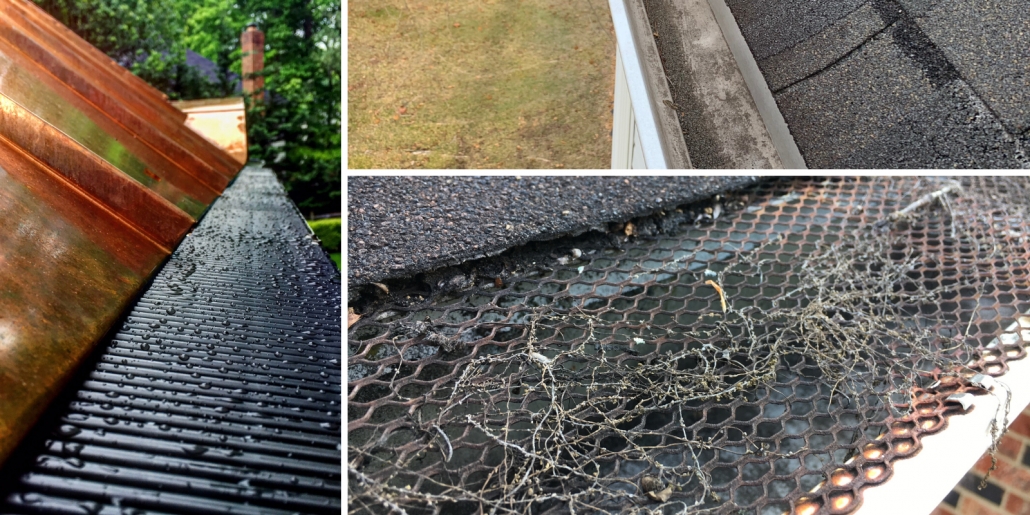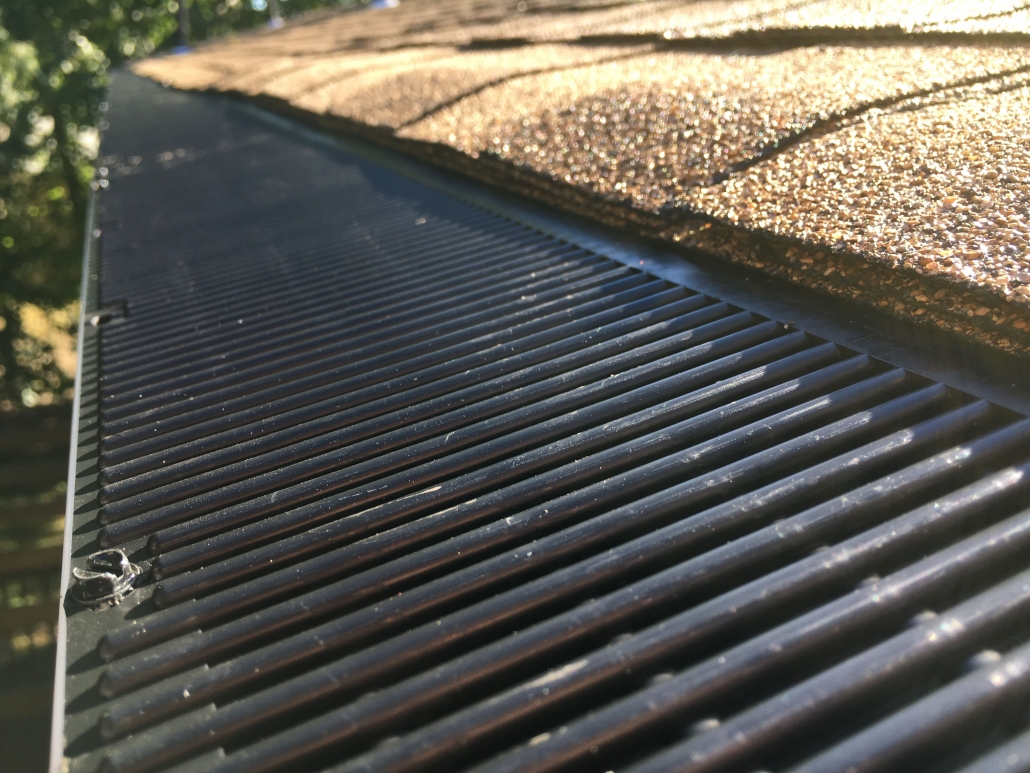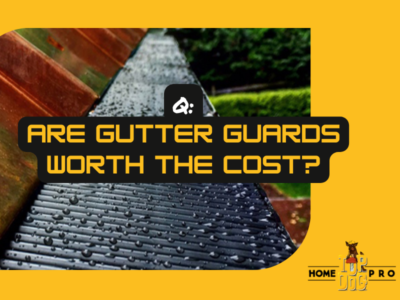A common question we get asked when it comes to gutters and gutter guards is, “Are gutter guards worth it?”
As one of the leading residential gutter contractors in the Northern VA area, one of the most common questions we get from homeowners as it pertains to gutters is whether or not gutter guards are genuinely worth the cost and installation!
We understand why people ask the question. Similar to how car dealers often throw in a “Must Have Warranty” when purchasing a car, gutter guards are more than just an add-on. The proper gutter guards serve a purpose.
In this article, we hope to help you identify and figure out quickly:
- The value behind gutter guards & what gutter guards do.
- Issues with selecting the WRONG gutter guards.
- What your best options are when it comes to selecting gutter guards?
That being said, let’s dive in and start by answering one of the most frequently asked gutter questions:
First, what are gutter guards?

Gutter guards are simply guards or covers that protect your home’s rain gutters from clogging. The idea is simple. If you go about installing gutter guards you will prevent clogs from forming in your gutters.
Gutter clogs can lead to a multitude of issues, such as:
- Foundation issues
- Soil erosion
- Basement flooding
- Water leaks in your home/around your roof
- Overflowing gutters
These will often occur when debris buildup within your gutters. Clogged gutters prevent water flow from entering downspouts which ultimately displace rainwater during storms away from your home.
What do gutter guards do?
Essentially, a gutter guard is placed over your gutters, or an object is placed inside your gutters, to prevent any leaves, sticks, pine needles, and other debris from clogging your gutters.
Selecting the right gutter guards should allow water to easily flow, enter the gutter, and drain away from the house without impeding water flow.
When clogged, gutters can overflow. If too much water gets caught within your home’s gutters, it may overflow and cause water damage. Gutters may sag or pull away from your roof, potentially causing it to rot, mold, or cause structural damage to the home.
Just look at these photos below of gutters that don’t have guards and once a gutter guard is installed:



Are gutter guards worth the investment?

In our opinion, the proper gutter guards are worth it! The ideal gutter guards should make your gutter’s health and longevity last a lifetime. Additionally, maintenance of your gutters is made easier when you have self-cleaning gutter guards (more on those later).
In this article’s cover photo above, going clockwise, you see clean empty gutters, screen gutter guards (that are damaged), and surface-tension Raindrop gutter guards.
Financially speaking, the initial investment of gutter guards can save you plenty of time and money over just a few years once they are installed, depending on the type of guard you decide to purchase.
Whether or not you install the guards yourself or have it professionally installed, the answer to the question of whether gutter guards are worth it is not so straightforward – it depends.
While it may keep maintenance and make cleaning a lot easier, it is NOT the ultimate solution to never having to clean your gutters again in most cases (Keep reading to see what is).
How much do gutter guards cost?
Gutter guards range in price and are based off linear foot. While we recommend professional installation of all gutter guards (safety and to ensure properly installed) costs can range for the product itself.
Professionally installed gutter guards factor in the type of gutter guard and also the install price. Most gutter guards will range from the low end of $10 per linear foot up to $25 per linear foot.
Put another way, a home that needs 100 feet of gutter guard would cost somewhere between $1,000 and $2,500, depending on the type of gutter guard.
Pros of Installing Gutter Guards:
The pros of gutter guards outweigh the cons vastly in our professional opinion. For starters, without gutter guards, your gutter system is left vulnerable to damage.
Here are the pros to why you should install gutter guards:
- Gutter guards keep your gutters healthy and working
- Increase the longevity of your rain gutter’s durability
- You don’t have to clean your gutters with the right gutter guards
- Surface tension gutter guards are self-cleaning and block debris
- Prevent birds and other rodents from nesting in gutters
- Gutter guards can pay for themselves in 2-4 years based on gutter cleaning prices
- It can even prevent fire hazards since clogged gutters with dry leaves are fire hazards
Problems with Gutter Guards (Cons):
- It may require cleaning if you select the wrong gutter guards
- Gutter guards can be super expensive
- Unlike gutters, not all gutter guards are created equally; therefore, some require maintenance.
- Gutter screens can contribute to clogging if you use cheap gutter guard covers or screen guards.
- Pine needles can still make it through them.
- If needing cleaning, it can add to the gutter weight and stress older gutters
- Gutter guards DIY – not a good idea!
How to pick a good gutter guard:
Invariably, if you search for gutter guard issues, you will see many problems. When deciding on gutter guards, you want to select a gutter guard system that is:
- Self-cleaning
- Requires minimal maintenance to no maintenance at all.
- Prevent larger debris and also smaller debris
- Doesn’t cost more than $1500-$2500 for your home (single-family home)
- It still lets the gutters do their job.
- Has a warranty! (See our gutter guard warranty)
If the gutters you are looking for don’t meet the above specifications, you shouldn’t use them.
Types of Gutter Guards
Similar to picking up toothpaste at the store, and coincidentally suffering from paralysis by analysis, there are quite a few varieties of gutter guards to choose from. The standard gutter guards include:
- Brush,
- Foam,
- Reverse-curve or slit guards,
- Micromesh,
- Metal Screens,
- Surface Tension Gutter Guards (Our top pick)
Each of the above gutter guards has its list of advantages and disadvantages when it comes to installing these guards on your gutters. And whether you can do it yourself or you must have it installed professionally depends on the guard.
However, preventing debris from clogging the gutters, and the amount of maintenance required to keep the gutters clean and working properly depends on the guard (You can read this article ranking the best types of gutter guards)
This is also important to note, that when deciding whether or not gutter guards are worth it, it’s best to look at the possible problems.
Brush gutter guards:
They are made of strong bristles and are easily installed by inserting it along the inside of the gutter and give the rainwater a chance to flow and drain. While the installation is easy, the maintenance can be a bit of a hassle as debris such as leaves may collect alongside the bristles or at times be stuck on them. Furthermore, they don’t catch smaller debris like maple spinners or pine needles. To reach and clean the smaller debris, you must remove the brush gutter guards altogether, clean them, and reinstall them again.
Foam gutter guards:
Like brush gutter guards, they install the same way and are easy to do. However, just like brush gutter guards, foam gutter guards collect debris on top of the foam. Seeds may get caught inside the foam and grow vegetation, mold, and mildew. Foam guards are usually not a great long-term solution as they usually deteriorate after two years of use and become brittle. Cannot withstand harsh weather conditions.
Lastly, you must uninstall them and reinstall them if you want to give a proper cleaning. Also, gutter guard DIY are usually foam gutter guards!
Reverse-curve gutter guards or slit guards:
Cover over your gutters and move rainwater and debris downwards; the majority of these guards must be professionally installed. Some of these guards lift your roof shingles, potentially voiding your warranty. Aesthetically, they don’t look all that well since they are noticeable from the ground; furthermore, since the debris falls downwards, they collect underneath where the gutter is located. Debris may get caught on the slit and slowly clog the gutter. Lastly, you may have a pest issue as some bees or wasps enter the slit and create a nest.
Micromesh gutter guards:
They are usually a screen/filter with holes invisible to the naked eye and are attached at the top of the gutter, allowing water to flow freely while catching debris of all sizes. Micromesh is usually installed by professionals, making them a bit more expensive than a DIY solution but well worth the cost. Plastic frames typically fall over time; always opt for an aluminum or metal frame.
Metal screeners & screen guards:
Like micromesh, they are attached at the top of the gutter but can be clipped on the gutter’s outer lip. Stainless steel micromesh leaf guards must be properly installed and adequately maintained. The holes on the metal screens allow rainwater to flow; however, they also allow small debris to flow. Furthermore, nuts and some leaves may clog the opening of the screen, interrupting water flow and causing it to clog. In high winds, they may be lifted and blown off.
Gutter Guards that Work – Surace Tension (Raindrop) Gutter Guards
Surface tension gutter guards completely cover your gutters. Raindrop Gutter Guards (surface tension) are relatively easy to install and are our HIGHEST ranked gutter guards.
Raindrop Gutter Guards are surface-tension guards that are SELF-CLEANING, yet they still let water move through and go down your downspouts. Known for their extreme durability, they can withstand heavy blows – like a falling branch – and ice.
In addition to being durable and allowing water to flow through, Raindrop guards are self-cleaning so that we can offer a no-clog warranty! Most gutter guard companies do not offer this!
The gutter guards are installed under the roof shingles and attached to the front of the gutter, creating a solid surface that can withstand heavy storms. Raindrop’s design is simple:
- Keep the leaves out
- Let the rain in
- Last Forever
- Require minimal maintenance, in fact, the only time Raindrop needs cleaning is when pine needles collect in the corner of a gutter.
Installing Raindrop Gutter Guards:
Usually, the installation can be customizable. Raindrop gutter guards can be inserted underneath your shingles (as mentioned) and placed over your gutter, and drilled on the outer lip of the gutter to secure it better.
Using this method, the gutter guards are at the appropriate slant to allow for water flow, yet unlike mesh guards that are flush mounts – you won’t have leaves pile up on top.
Made from its own unique blend of polypropylene, Raindrop gutter guards allow water to flow freely and have debris fall off the gutter, preventing it from getting clogged. These gutter guards are not visible and appear to be the shadow of the roof from the ground.

Final Word on Why Gutter Guards:
There are a variety of gutter guards, and truth be told, you can select the wrong guard.
If the point is to protect your gutter system so you don’t have to clean them, then in our experience over the years, the only choice is Raindrop gutter guards.
Raindrop gutter guards are worth it, and do your best to protect your home from harsh winter snow, ice, and heavy rainfall. Making it an intelligent investment in your home in which you can save plenty of time and money on your gutter maintenance.
Whether you decide to install it yourself or have it installed professionally (which we recommend).Lastly, be sure to do your research and due diligence regarding what gutter guard is best for you and your home, and don’t just take our word for it.
However, we are confident, that the more you look into seeing the value of what gutter guards are worth, you will quickly realize Raindrop is the best – and they don’t pay us to say that!


 13+ Firework Safety Tips for You & Your Home!
13+ Firework Safety Tips for You & Your Home!